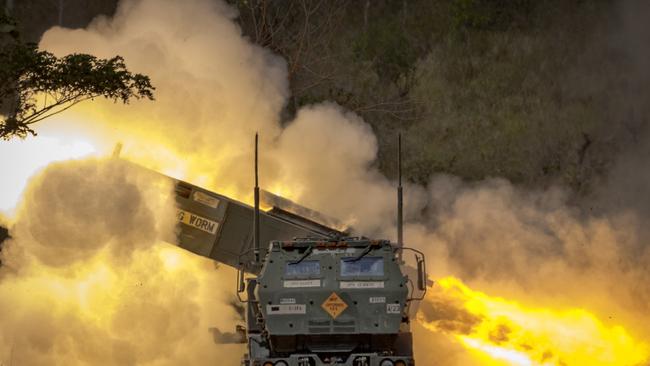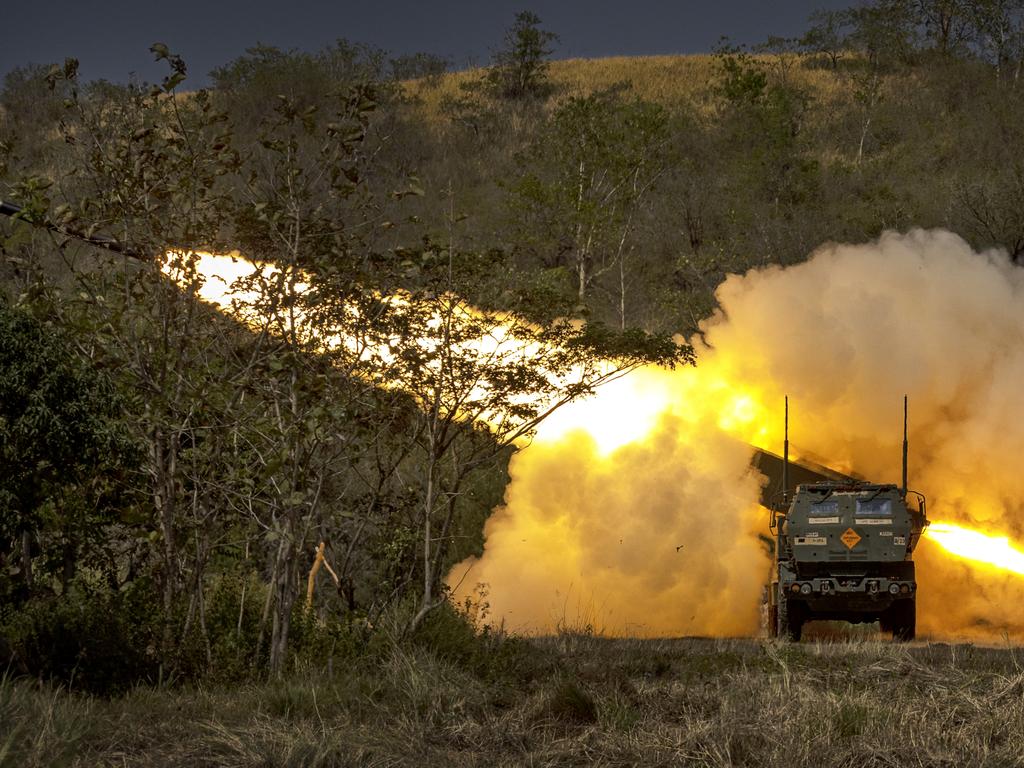‘Show us the money’: history cautions against defence spending failure
The creators of the 1986 Dibb report urge the government to fund the new review’s findings.

The release of the Defence Strategic Review on Monday predictably resulted in a plethora of comments by defence and security experts.
They seem to lurch between two extremes: on the one hand there is the assertion that this is none other than a covert plot for the government to lock Australia into a US war with China over Taiwan. On the other hand – and it is sometimes the selfsame people – there is the view that this is not much more than a repetition of the defence of Australia doctrine articulated more than 30 years ago in the Dibb review.

Our view is that it is neither of those extremes, and by and large reflects sound strategic policy
advice. However, we have differences with the DSR about some force structure issues and how they are arrived at, as well as some serious topics – such as mobilisation – that are not addressed in the DSR.
The central strategic policy guidance in the review is the introduction of the concept of deterrence by denial. We both argued for the acceptance of this concept in May 2021 in a publication by the Australian Strategic Policy Institute called Deterrence Through Denial: A Strategy for an Era of Reduced Warning Time. We argued the probability deterrence would work was reinforced if we had a more certain ability to deny an attacker the achievement of its military objectives. Solid deterrence provides a hedge against surprise, raises the cost to an adversary of action against Australia’s interests, and – if sufficient – makes an enemy’s attack irrational.
The bottom line for defence policy is that, as confidence in deterrence by denial goes up, our dependence on early response to warning should go down. Moreover, it would be easier and cheaper to go to a higher state of alert with this concept than with one based on deterrence through punishment, which implies attacking the adversary’s territory.
The DSR appears to accept all this and focuses on the capacity to deter a potential adversary with long-range strike missiles in our area of primary strategic concern. The review defines this area as encompassing the northeastern Indian Ocean through maritime Southeast Asia into the Pacific, including our northern approaches.
Of course, were an adversary to gain access to a military base in such places as Solomon Islands or Vanuatu, we would then also have to contemplate such a threat to our heavily populated eastern approaches.
There are several issues in the DSR that did not receive sufficient explanation. For example, why did the review not make a recommendation about whether we should go ahead with the $50bn of Hunter-class frigates – rather than simply passing the parcel to yet another independent analysis? And why is the army’s bid for new US Abrams tanks not cancelled?
The DSR admits that defence is facing “significant workforce challenges” (which Defence Minister Richard Marles acknowledges), and this was a recurring theme for the DSR across all areas of the ADF, defence public service and defence industry. This is an acute issue for Defence. Also, the growth in star-rank levels (brigadier equivalent and above) has been astonishing over the past two decades. Current (June 2022) figures are navy 58, army 86, air force 61, and APS 156. A comprehensive review recommended by DSR of the ADF Reserves, including consideration of the reintroduction of a Ready Reserve scheme, is a good idea.
But another important workforce issue is not mentioned by the DSR at all. And that is under what conditions would we need to mobilise not only the Defence Force and its supporting public service – including the intelligence community – but how would nationwide mobilisation work in a real security crisis when there would be mutual competition for key staff between military, civilian, defence industry and reserve forces.
It is true the DSR has a chapter on force posture and preparedness, but it does not address the issue of mobilisation at all (even though it is listed in the terms of reference). Why not, when it is well-known that the Defence organisation has been working on such an analysis for several months?

The DSR makes strong criticisms of the Capability Acquisition and Sustainment Group within the Defence Department. The review bluntly says: “Defence’s current approach to capability acquisition is not fit for purpose – the system needs to abandon its pursuit of the perfect solution or process and focus on delivering timely and relevant capability.”
It concludes that Defence’s acquisition process “is not suitable given our strategic circumstances” and there is a clear need for a more efficient acquisition process.
The volume and complexity of capability projects is overwhelming Defence’s capability system, its limited workforce and its resource base. The DSR says Defence’s problems with acquisition result in delay and “strategically significant capability outcomes not being achieved in a timely manner, or at all”.
The review recommends that “Defence must, where possible, acquire more platforms and capabilities via sole-source or off-the-shelf procurement, and limit or eliminate design changes and modifications.” It claims to have “seen evidence of contractors managing contractors through several layers of a project’s governance structure with inadequate commonwealth oversight”. It stresses that mechanisms put in place to manage risk in Defence acquisitions “do not serve us well in the current strategic environment – they are burdensome and misguidedly risk averse”.
The DSR concludes that options should be developed as soon as possible to change Defence’s capability acquisition system “so that it meets requirements and is reflective of our current strategic circumstances”.
So, the DSR marks a significant break from the defence policies that have dominated most of the past 50 years. It recognises the serious deterioration over recent years in Australia’s strategic circumstances. While reinforcing many of the changes set out in the Coalition’s 2020 defence strategic update, it also proposes some important new directions for the structure and posture of the ADF.
Because the public version of the review omits any sensitive material, some of its recommendations are more implied than explicit.
In some respects, it is a pity the review drops the expression “defence of Australia”, for there remains much continuity in the new era with the policies of the earlier period. Rather, the key change is that the notion of the core force and expansion base is no longer valid. Instead, the central idea for today’s circumstances, when extended warning time no longer applies, is the need for a contingency force with a surge capacity. The review goes a long way towards recognising this, although its lack of discussion of mobilisation is a weak point.
The point is that under the old policy regime, Australia was able to get away with a small peacetime defence force at peacetime levels of preparedness, capable of little more than routine peacetime operations and training, supported by an Australian Intelligence Community, policy community and industry base also at peacetime levels. Clearly this is no longer appropriate.
Although the DSR says little on it, it is clear that readiness and sustainability are now a major concern. For example, the review says in effect that a platform without crew or weapons is a waste of time and money.
It makes explicit the need to increase aircrew numbers. This is a serious indictment of current Defence culture. The review does not provide an indication of the costs of fixing this problem but implies that they will prove significant. The review’s support for the acquisition of uncrewed platforms (submarines and the RAAF’s Ghost Bat autonomous air vehicle are mentioned) – and for a program for manufacturing modern and highly capable precision-guided weapons in Australia – is most welcome.
This is for two reasons. It will enable Australia to move quickly to implement the policy of deterrence by denial, especially through long-range precision strike missiles. And it offers a more convincing mode for timely force expansion than the previous, largely implicit assumption that force expansion would be through the acquisition of additional, complex and costly major platforms. It is perhaps significant that the review does not propose the acquisition of further major platforms beyond those already planned, although the recommended independent analysis of the navy’s surface fleet could well propose such changes.

In many respects it is the army that will undergo the most significant change. This will entail a refocusing of priorities. The extent of this change raises questions about governance processes within Defence: why had Defence itself not realised that the direction in which the army was moving was not well-matched to Australia’s emerging strategic circumstances? There is an echo here of the factors that led to the need for the review of Australia’s defence capabilities almost 40 years ago: issues even then concerning the planning priorities for the army had been much more contentious, and left unaddressed, than those for the navy or the air force.
Nevertheless, the new and re-articulated responsibilities for the army will increase its importance and relevance. For example, land-based long-range anti-ship missiles will have a vital part to play in the policy of deterrence by denial. Handling the technological complexities of precision targeting will be made easier by the transition to the review’s culture of an integrated force. Put plainly, it will be important for the army’s anti-ship missile units to be well-supported by the navy and other Defence elements. And the strengthened focus on littoral operations is clearly relevant to Australian priorities. It will be important, however, for the limits to what is intended here to be spelled out as, taken to extremes, the resource demands would be unrealistic, and the priority doubtful.
Explicit in earlier policies was the expectation that intelligence analysis would indicate Australia’s strategic environment was deteriorating, and that government would act on this advice. We have been concerned for some years that the machinery of government was proving slow to recognise strategic change, and even slower to act on this recognition. The review serves to reinforce this concern.
Throughout, for example, it emphasises the need for urgency in effecting its recommendations. And there are many other examples of its concerns about outdated policies and no-longer-appropriate priorities for resource allocation.
These are issues of governance, not necessarily only within the Defence Department. For example, the review emphasises the importance of taking an integrated, whole-of-government approach to national defence – indeed, the latter is the document’s title.

We are surely entitled to ask what has been going on for this statement of the obvious to require such prominence.
Looking at yesterday’s governance issues is useful because it is important not to repeat past mistakes. But concerns go beyond this. The most recent review of the Australian Intelligence Community was in 2017, well before today’s security perspectives developed. It would be timely to be reassured that the AIC is well-placed to meet the demands of today’s priorities, including through having a surge capacity to meet 24/7 contingent developments.
For Defence itself, there is no unique approach to governance, and practise has tended to reflect the issues and priorities of the day, going back to the Tange reforms of the early 1970s. The most recent review was conducted in 2015 – the First Principles (or Peever) review – long before today’s strategic anxieties developed.
These observations, together with the review’s telling criticisms of current practice and the difficulties that lie ahead in implementing the DSR’s recommendations, reinforce the need for a thorough examination of governance, both within Defence and within the machinery of government more generally, to ensure that it’s fit for purpose in today’s changed circumstances.
In summary, the DRS is an important and major step along the road of much-needed reform. As always, the key will be in the implementation of its findings. The government must avoid past failures of not following through on the reform program.
And, as always, there is the question of finding the money. Defence will have to be ruthless in weeding out any lower-priority proposals.
History provides a caution: only four years after the 1987 defence white paper, Defence was advising the then defence minister that should “financial allocations fall below no real growth over the decade, such a reduced program would preclude the maintenance of a strategy of defence in depth as outlined in the white paper”. It is reassuring, then, that the Prime Minister, when launching the DSR, acknowledged that there would be a requirement for increased defence spending beyond the forward estimates. We must hope that he keeps his word.
Paul Dibb is emeritus professor of strategic studies at the Australian National University. Honorary professor Richard Brabin-Smith is a former defence deputy secretary and was senior adviser to the 1986 Dibb review.






To join the conversation, please log in. Don't have an account? Register
Join the conversation, you are commenting as Logout